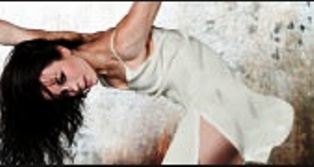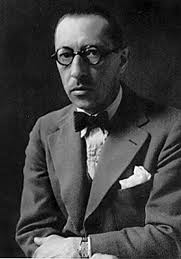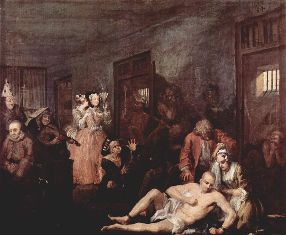
Two Faces of Stravinsky
(first published at www.expresscincinnati.com)

Spring is in the air – and so, apparently, is Stravinsky.
There will be performances this month of two of his major works, “The Rite of Spring” and “The Rake’s Progress” -- and on the same weekend, too,
Cincinnati Ballet presents “The Rite of Spring” at 8 p.m. March 16 and 2 and 8 p.m. March 17 at the Aronoff Center. Stravinsky’s music will be performed live by the Cincinnati Symphony Orchestra conducted by Cincinnati Ballet music director Carmon DeLeone. The Cincinnati Chamber Orchestra and the Vocal Arts Ensemble collaborate on a concert performance of “The Rake’s Progress” led by CCO music director Mischa Santora at 2 p.m. March 18 in Corbett Theater at the School for Creative and Performing Arts.
Also on the CB program are Vivace, a non-narrative piece in classical style by choreographer Val Caniparoli, set to Schubert’s Symphony No. 2 in B-flat Major, D. 125, and “Oneself Perceived” by “So You Think You Can Dance?” choreographer Stacey Tookey to four short pieces by Icelandic composer Ólafur Arnalds (a world premiere).
(Note: The opera department of the University of Cincinnati College-Conservatory of Music will stage “Rake’s Progress” May 10-13 in Corbett Auditorium.)
Those who attend both works will experience opposite sides
of the composer. “The Rite of Spring,”
storied ground-breaker for 20th-century music, exemplifies Stravinsky’s
early Russian period. Famous for its rhythmic
complexity and use of dissonance, it caused a riot at its premiere in 1913 in
Paris. “The Rake’s Progress” (1951),
inspired by the paintings of the same name by William Hogarth, capped
Stravinsky’s neo-classical period and is intimate and tonal by contrast.

The original “Rite of Spring” (“Le sacre du printemps” in French) was created by Stravinsky for Sergei Diaghilev’s Ballets Russes, with choreography by Vaslav Nijinsky. It depicts a pagan Russian ritual where a maiden is sacrificed to the god of Spring. Conventional wisdom to the contrary, the uproar that accompanied the premiere -- booing, shouting, fistfights (the Paris police tried to restore order) -- was most likely not because of Stravinsky’s music, said DeLeone.
“That’s been such a legend through the years (promoted by Stravinsky himself) and Diaghilev just loved it. Like any producer, it means he’s going to sell a ticket. According to the accounts, it was not necessarily the music, but the choreography, what they were seeing onstage.” (Nijinsky’s original choreography has been lost, but attempts to reconstruct it indicate it involved heavy, angular movement, quite out of step with classical ballet.) “I have a theory that composers in recent times have been able to get away with more in terms of avant-garde trials in music when it’s matched to dance, because it’s not just a listener listening to the material,” said DeLeone (who is also a composer). “Your brain is being entertained in two different ways. It’s like movie music. There is music that goes on behind the scenes of motion pictures that one would never sit down and listen to in a concert.”
Choreographer for “Rite of Spring” is CB resident choreographer Adam Hougland, who created it in 2009 for Louisville Ballet (where he is principal choreographer). As was his “Firebird” (Stravinsky) for CB last season, Hougland’s “Rite” is updated for a 21st-century audience.
Designed by Marion Williams (designer of “Firebird”), the set looks like “an abandoned, underground subway station or locker room. It’s all tiles and rusted pipes, very creepy and dark,” said Hougland. “Stravinsky’s narrative speaks of reverence for the earth. I don’t feel like we have much reverence for the earth. I’m basically trying to show a society that has completely divorced itself from anything natural.
“It has a very simple sort of narrative. There’s a central figure who is picked from the group (the Chosen One). When they see this woman, who is like that last saving breath of anything human, they destroy her.”
Her costume -- tighter, lighter-colored and grayish -- differs from that of the corps de ballet, and her movements are completely different, said principal dancers Sarah Hairston and Janessa Touchet, who will alternate the Chosen One. The group’s movements may be “aerobic or somber,” said Hairston, “but she is “in a desperate state.” “She’s “very afraid,” said Touchet, with angular movements that suggest screaming. In fact, added Hougland, “She is pleading for her life.”
She meets an unexpected end, said DeLeone, who conducted the 2009 premiere at Whitney Hall in Louisville. “You start seeing this stuff coming down from the ceiling and you think, gee, that looks like snow . . .” If you saw the Louisville Ballet production in 2009, you know the rest. For now (Hougland said he would prefer to keep it a surprise), think Gene Kelly.
The CSO will comprise 70 musicians (“Rite of Spring” has a huge instrumentation). To accommodate them, the pit at the Aronoff has been expanded. “The Aronoff has always had an expandable pit,” said DeLeone, “but it’s never been used except when the Aronoff first opened, for their gala celebrations. After that, they put in a floor to allow two more rows of seating and it shortened the pit. For ‘The Nutcracker’ (in December) we finally took out those two rows of seats. Every time the CSO performs with us, it will be expanded.”
The CSO will not accompany the Ólafur Arnalds premiere, said DeLeone. “It’s very listenable material,” he said, “chamber style and very atmospheric (hear one of the pieces, “3055,” from his album “Eulogy for Evolution” on the composer’s web site, olafurarnalds.com). It has some special synthesized effects and the sound of the human voice, but altered in such a way that we wouldn’t be able to re-create that, so that will be done with the original recordings of those pieces.“ The Ballet describes the work as “abstract, but intensely personal” and concerned with fear (personified by the male dancers, with the women deciding whether to conquer or be conquered by it). Says choreographer Tookey: “Fear keeps us safe. Protects us and keeps us from challenging ourselves. We struggle with it, but it often wins. How do we gain enough courage to stand up to fear? And most of all, what would life be like without it?”
Tickets for “The Rite of Spring” start at $30, available by calling (513) 621-5282, or visit www.cballet.org
Concert opera is an important niche for the Cincinnati
Chamber Orchestra, which has presented fine performances of Purcell’s “Dido and
Aeneas” and Mozart’s “Cosi fan tutte” and “Don Giovanni” in recent years. Stravinsky’s opera “The Rake’s Progress,” to be
performed at 2 p.m. March 18 in Corbett Theater at the School for Creative and
Performing Arts, also marks the annual collaboration by the CCO and the Vocal
Arts Ensemble. CCO music director Mischa
Santora will conduct. Roles will be sung
by guest artists and members of the VAE.

(Note: the opera department of the University of Cincinnati College-Conservatory of Music will stage “Rake’s Progress” May 10-13 in Corbett Auditorium at CCM.)
Stravinsky was inspired to compose “The Rake’s Progress” after viewing William Hogarth’s famous paintings about the misadventures of a wealthy playboy (rake) in 18th-century London. For the libretto, he enlisted poets W. H. Auden and Chester Kallman and devised a scenario based on Hogarth’s images: A country boy, Tom Rakewell (tenor Scott Ramsay), leaves his fiancé Anne Truelove (soprano Nadine Sierra) and heads for London after being told by a mysterious visitor, Nick Shadow, i.e. the Devil (bass-baritone Gus Andreassen), that he has inherited a fortune. Tom pursues a dissolute life in London, where he marries a bearded lady, Baba the Turk (mezzo-soprano Kirstin Chavez), and squanders his money on a fake bread-making machine, foisted on him by Shadow. Tom ends up broke and at the mercy of Shadow, who claims his soul. Shadow allows Tom to decide his fate in a game of cards. Inspired by thoughts of Anne, Tom wins, but Shadow strikes him insane. Tom dies in an asylum, where the faithful Anne visits him and sings him a final lullaby.
VAE members will sing the roles of the brothel-keeper Mother Goose (mezzo-soprano Kirstin Chavez), Father Truelove (bass Thom Mariner), the auctioneer Sellem (tenor Andrew Jones) and the keeper of the madhouse (bass Jonathan Stinson). As the chorus for the opera, the VAE will enact whores, gamblers, drunks, servants, citizens of London and inmates of the insane asylum.
The opera, which runs 2 ½ hours uncut (there will be some paring for this performance), premiered in Venice in 1951. It is a classic “number” opera, with arias, recitatives, choruses and harpsichord accompaniment. Many critics, impatient with what they viewed as Stravinsky’s retreat from the vigorous experimentation of his first period, gave it negative reviews, but it has since been acknowledged as a masterpiece for its unique blend of craftsmanship, wit and lyricism. It is scored for a chamber-sized orchestra and recalls Mozart, especially “Cosi fan tutte.”
VAE music director Donald Nally has prepared choruses for “The Rake’s Progress” for the Festival of Two Worlds in Spoleto, Italy, and Opera Company of Philadelphia. “I love it so much,” he said, “partly because it’s so funny. And it’s really moving at the end. The combination of these witty, intelligent authors with this amazingly wry composer -- they produced this crazy piece of genius.”
The chorus has a very special role in the opera, Nally said. “In a lot of operas, the chorus master has to work hard to keep the singers really engaged, since they are often treated as a kind of back-up. In ‘Rake’s Progress,’ that’s not possible, because they play such wonderful characters and are so integral to the way the piece develops: the way they comment, taunt and make transitions, from being The Roaring Boys and Whores, to people buying and selling at the auction, and the social comment they make on the way people actually behave. At the end, they serve as a kind of Greek chorus in the way they sing to Tom (who thinks he is Adonis). It’s very beautiful.”
Tickets for “The Rake’s Progress” are $10, $5 for children under 18, free for active duty servicemen and women and their immediate families. Call (513) 723-1182, ext. 102, or visit www.ccocincinnati.org